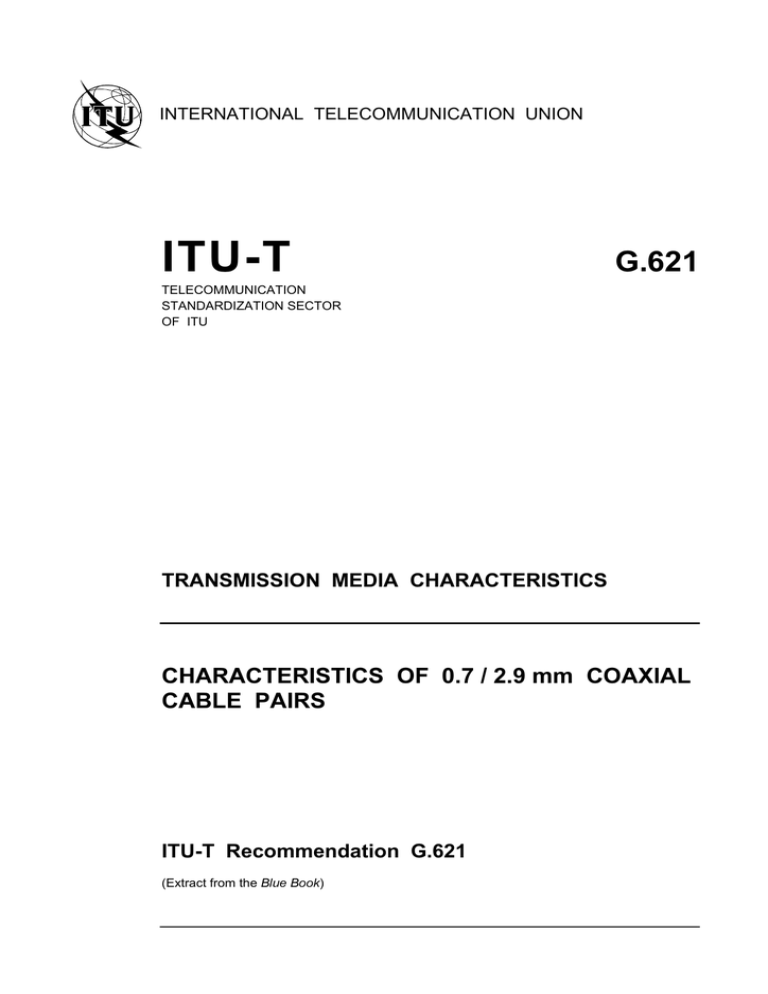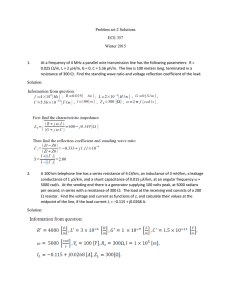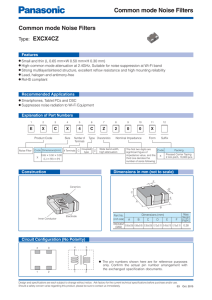
INTERNATIONAL TELECOMMUNICATION UNION
)454
'
TELECOMMUNICATION
STANDARDIZATION SECTOR
OF ITU
42!.3-)33)/. -%$)! #(!2!#4%2)34)#3
#(!2!#4%2)34)#3 /& MM #/!8)!,
#!",% 0!)23
)454 Recommendation '
(Extract from the "LUE "OOK)
NOTES
1
ITU-T Recommendation G.621 was published in Fascicle III.3 of the Blue Book. This file is an extract from
the Blue Book. While the presentation and layout of the text might be slightly different from the Blue Book version, the
contents of the file are identical to the Blue Book version and copyright conditions remain unchanged (see below).
2
In this Recommendation, the expression “Administration” is used for conciseness to indicate both a
telecommunication administration and a recognized operating agency.
ITU 1988, 1993
All rights reserved. No part of this publication may be reproduced or utilized in any form or by any means, electronic or
mechanical, including photocopying and microfilm, without permission in writing from the ITU.
Recommendation G.621
Fascicle III.3 - Rec. G.621
CHARACTERISTICS OF 0.7/2.9 mm COAXIAL CABLE PAIRS
(Geneva, 1976; amended at Geneva, 1980)
Administrations which decide to use for digital transmissions, and possibly also for particular types of analogue
transmission, coaxial pairs smaller than the 1.2/4.4-mm coaxial pair should as far as possible choose pairs complying
with the specifications given in this Recommendation. The use of these pairs is defined in Tables 1 and 2 given in the
introduction to Subsection 6.2.
1
Pair characteristics
1.1
Electrical characteristics of the coaxial pair
1.1.1
Characteristic impedance
The nominal value of the real part of the characteristic impedance at 1 MHz should be 75 Ω.
The mean real part of the impedance of a coaxial pair at 1 MHz should not differ from the nominal figure by
more than ± 2.5 Ω.
Table 1/G.621 shows the general trend of the variation of the impedance as a function of frequency.
TABLE 1/G.621
Mean real part of the impedance measured at various frequencies
Frequency (MHz)
Impedance (Ω)
1.1.2
0.2
0.5
1
77.7
75.9
75
2
5
10
20
∞
74.2
73.4
73
72.8
72.2
Attenuation coefficient
The nominal value of the attenuation coefficient, at 10 °C and at 1 MHz, is equal to 8.9 dB/km.
Table 2/G.621 shows the general trend of the variation in attenuation coefficient as a function of frequency at
the temperature 10 °C.
TABLE 2/G.621
Mean values of the attenuation coefficient at various frequencies
Frequency (MHz)
0.2
0.5
1
2
5
Attenuation coefficient (dB/km)
4.5
6.5
8.9
12.6
19.8
1.2
10
20
28.0
39.6
Mechanical construction of the coaxial pair
The pair has the following constitution:
a)
nominal diameter of solid-copper wire inner conductor: 0.7 mm;
Fascicle III.3 - Rec. G.621
1
2
2.1
b)
nominal internal diameter of outer conductor: 2.9 mm;
c)
outer conductor consisting of a copper tape with a thickness of the order of 0.1 mm, laid lengthwise with
overlap1) ;
d)
screen consisting of a steel tape with a thickness of the order of 0.1 mm, laid lengthwise with overlap 1).
Cable specification (factory lengths of about 500 m)
Characteristic impedance
To check that the value given in § 1.1.1 is met, pulse measurements can be made. The mean real part of the
impedance at 1 MHz is to be taken as meaning the resistive component of the impedance at 1 MHz of the network with
the best balance against the coaxial pair measured.
2.2
Impedance regularity
Routine control measurements of impedance regularity are carried out by means of pulse echometers from one
or both ends of the factory lengths. The echo curve should be plotted with correction in amplitude and if possible in
amplitude and phase.
Table 3/G.621 shows the various values to be obtained according to the purpose for which the cable is intended.
TABLE 3/G.621
Echometric measurement of factory lengths a)
Type of system
Digital
Medium bit rate
(6 to 34 Mbit/s)
Bit rate
Maximum pulse duration
General provisions
100 ns
100 %
36 dB
95 %
39 dB
Maximum peak
A
Mean of 3 maximum peaks
B
Equivalent resistance error
39 dB
Additional optional provisions a)
a) It is enough to cheek that one of the two conditions A or B is fulfilled.
Note 1 - The percentage figures given in the table relate to all the pairs of a batch of cables submitted for
control or delivered at the same time.
Note 2 - With the construction techniques used so far, systematic faults do not give rise, in steady-state
measurements of regularity return loss, to peaks at frequencies below 60 MHz. For this reason, and taking
_______________
1)
A single bimetallic copper-steel-copper tape may also be used to serve as outer conductor and screen.
2
Fascicle III.3 - Rec. G.621
into account the bit rate envisaged, steady-state measurements of regularity return loss do not seem
necessary. For other types of construction which might be used in future, supervision of the regularity return
loss might be wise; in such cases, the value should be 20 dB from 4 to 60 MHz.
2.3
Attenuation coefficient
The attenuation of pairs should be such as to allow compliance with the provisions of § 3.3 below 2) .
2.4
Near-end crosstalk attenuation
The near-end crosstalk attenuation between coaxial pairs used for different transmission directions, measured in
the frequency band 0.5-20 MHz on factory lengths, must be above 135 dB for 100% of measurements.
2.5
Dielectric strength
The pair should withstand an a.c. voltage of 1000 r.m.s. at 50 Hz (or a d.c. voltage of 1500 volts) applied for at
least 1 minute between the centre and the outer conductor.
If in normal service the outer conductors of the coaxial pairs are not to be earthed, a dielectric strength test must
be carried out between the outer conductors and the earthed metal sheath. For this test, an a.c. voltage of at least
2000 volts r.m.s. at 50 Hz or a d.c. voltage of not less than 3000 V will be applied.
2.6
Insulation resistance
The insulation resistance between the centre and outer conductors of the coaxial pair, measured with a perfectly
steady voltage of between 100 and 500 V, should not be less than 10 000 MΩ-km after electrification for one minute at a
temperature not lower than 15 °C. The measurement of the insulation resistance should be made after the dielectric
strength test. This measurement should be made on every factory length.
3
Elementary cable section specification
It will be a matter for agreement between the Administration and the supplier whether tests are to be carried out
on all sections or whether some percentage or even a type-approval test alone will be sufficient, especially in the case of
measurements which are different to carry out under field conditions.
3.1
Mean impedance
The mean real part of the impedance of a coaxial pair at 1 MHz must not differ from the nominal value (as
defined in § 1.1.1) by more than 3 Ω. Measurements should be affected as described in § 2.1.
3.2
Impedance regularity
Measurements are effected as described in § 2.2 above. Table 4/G.621 indicates the various values to be
obtained according to the purpose for which the cable is intended. Note 1 of § 2.2 remains valid.
_______________
2)
At this stage of manufacture, attenuation measurements are merely prototype measurements.
Fascicle III.3 - Rec. G.621
3
TABLE 4/G.621
Echometric measurement of elementary cable sections
Type of system
Digital
Medium bit rate
(6 to 34 Mbit/s)
Bit rate
Maximum pulse duration
General provisions
100 ns
100 %
30 dB
95 %
33 dB
Maximum peak
A
Mean of 3 maximum peaks
B
Equivalent resistance error
33 dB
Additional optional provisions a)
a) It is enough to check that one of the two conditions A or B is fulfilled.
3.3
Attenuation coefficient
At 1 MHz, the real attenuation coefficient must not differ from the nominal figure, as defined in § 1.1.1, by
more than ± 0.4 dB.
Attenuation measured on a cable at an average temperature of t°C is referred to 10 °C by the formula:
The coefficient of the variation in attenuation as a function of temperature k α is about 1.8 ⋅ 10-3 per °C for
frequencies above 2 MHz and about 1.9 ⋅ 10-3 per °C for 1 MHz.
3.4
Crosstalk
The near-end crosstalk attenuation between coaxial pairs used for different transmission directions, measured in
the frequency band 0.5-20 MHz on 2- and 4-km sections, should be above 130 dB.
3.5
Dielectric strength
The pair must withstand a d.c. voltage of at least 1000 V applied during at least 1 minute between the internal
and external conductors.
In addition, a test of dielectric strength between the coaxial pair and earth shall be made as described in
§ 2.5 using a d.c. voltage of at least 2000 V applied for 1 minute.
3.6
Insulation resistance
The insulation resistance between the centre and outer conductors of the coaxial pair, measured with a perfectly
steady voltage of between 100 and 500 V should not be less than 5000 MΩ-km after electrification for 1 minute. The
measurement of the insulation resistance should be made after the dielectric strength test. This measurement should be
made on every elementary cable section.
4
Fascicle III.3 - Rec. G.621



